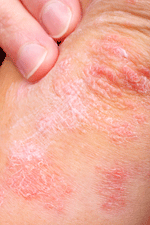 The deep territory of Chinese medicine yields a long line of health secrets. Slowly, we are bringing them into our Western society, but some herbal remedies remain clouded in mystique. Doctors Health Press attempts to bring them out for you. Here are the top six remedies for treating the inflammatory skin disease known as psoriasis.
The deep territory of Chinese medicine yields a long line of health secrets. Slowly, we are bringing them into our Western society, but some herbal remedies remain clouded in mystique. Doctors Health Press attempts to bring them out for you. Here are the top six remedies for treating the inflammatory skin disease known as psoriasis.
1) Xiao Yin Pian: This herbal combination containing 12 different plants is the best Chinese cure for psoriasis. It has been shown to have effects in reducing allergies and asthma — both linked to an inflammatory response in the body, much like psoriasis. In a study of 200 patients with the skin disease, Xiao Yin Pian treated 48% of them fully, improved symptoms in 38%, and failed to work in only 17% of patients. Patients recovered from psoriasis in an average of two months.
2) Yin Xiao San: This contains da huang (rhubarb), bai xian pi (dittany bark), chen pi (citrus peel), tu fu ling, niu huang, qing dai (indigo), and sheng di huang. In 200 psoriasis patients, researchers tested 7.5 g, three times a day. After a month, 70 patients fully recovered, 62 improved significantly, 36 improved moderately and 20 had mild improvements.
3) Tu Huai Yin: This formula consists of 11 different herbs, many of them included in the two listed above. The herb was given in liquid form, a decoction of 600 ml once a day in 62 patients. After 15 days, treatment was completed. After this, researchers mixed it with other herbs, and they washed their red, scaly skin for one hour every night. After 15 to 60 days of treatment, 46 people watched their psoriasis disappear, 12 had symptoms improve, and only four didn’t respond to treatment.
4) Tui Yin Tang: The final herbal mix we’ll list here contained nine plants. But for patients with active psoriasis, they added tu fu ling, shi gao, and dan pi. For those with the stationary disease, they added san leng, e zhu, and yu jin (curcuma root). In the end, 49 patients fully recovered, 43 had significant improvements, 10 had mild improvements, and just four did not respond to treatment.
5) Acupoint Catgut Embedding: This popular Chinese therapy is used for many conditions, including epilepsy, asthma, colitis, and ulcers. What happens is that, during acupuncture, surgical catgut is threaded through the needle. (Catgut is a very strong string, often used for violins, harps, and other instruments.) The needle is then put into specific spots that have been anesthetized, and the catgut is left in deep tissues. In a study, this was performed three times, in a span of about two months. At the same time, patients took 12 g of qing dai (indigo) a day. In all, 24 recovered fully and 18 significantly improved.
6) Acupuncture: In one study, good old-fashioned acupuncture was effective for 115 people with psoriasis. Needles stayed in for 30 minutes, and the number of needles depended on each person. The treatment lasted between 30 and 50 days. Twenty-five fully recovered, 54 had major improvement, 19 had moderate improvement, and 17 didn’t respond to the treatment.
